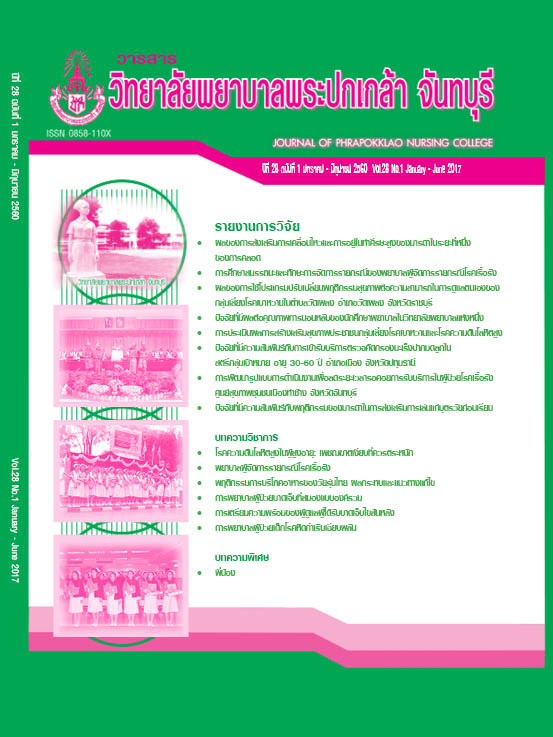การศึกษาสมรรถนะและทักษะการจัดการรายกรณีของพยาบาลผู้จัดการรายกรณีโรคเรื้อรัง
คำสำคัญ:
สมรรถนะและทักษะการจัดการรายกรณี, พยาบาลผู้จัดการรายกรณี, โรคเรื้อรังบทคัดย่อ
การวิจัยครั้งนี้เป็นการวิจัยเชิงพรรณนา เพื่อศึกษาความสำคัญและการมีสมรรถนะและทักษะการจัดการรายกรณีของพยาบาลผู้จัดการรายกรณีโรคเรื้อรัง กลุ่มตัวอย่างเป็นพยาบาลวิชาชีพผู้ผ่านการอบรมหลักสูตรการพยาบาลเฉพาะทาง สาขาการพยาบาลผู้จัดการรายกรณีโรคเรื้อรัง (เบาหวานและความดันโลหิตสูง) รุ่นที่ 1 วิทยาลัยพยาบาลบรมราชชนนี พระพุทธบาท จำนวน 51 คน เครื่องมือการวิจัยเป็นแบบสอบถาม แบ่งออกเป็น 3 ส่วน ได้แก่ ข้อมูลทั่วไป สมรรถนะการจัดการรายกรณี และทักษะการจัดการรายกรณี มีค่าความเชื่อมั่น .93 และ .85 ตามลำดับ เก็บรวบรวมข้อมูลในเดือนกรกฎาคม 2558 วิเคราะห์ข้อมูลด้วยสถิติความถี่ ร้อยละ ค่าเฉลี่ย ส่วนเบี่ยงเบนมาตรฐาน และ independent t-test
ผลการวิจัยพบว่าความสำคัญและการมีสมรรถนะการจัดการรายกรณีโดยรวมอยู่ในระดับมากที่สุด และระดับมาก ตามลำดับ (= 4.53, SD = .54 และ= 3.85, SD = .59 ตามลำดับ) ความสำคัญและการมีทักษะการจัดการรายกรณีโดยรวมอยู่ในระดับมากที่สุดและระดับปานกลาง ตามลำดับ (= 4.42, SD = .63 และ= 3.38, SD = .59 ตามลำดับ) และค่าเฉลี่ยคะแนนการมีสมรรถนะและทักษะการจัดการรายกรณี ต่ำกว่าค่าเฉลี่ยคะแนนความสำคัญของสมรรถนะและทักษะการจัดการรายกรณีอย่างมีนัยสำคัญทางสถิติ (t = 6.992, p < .001 และ t = 11.528, p < .001 ตามลำดับ)
จากการวิจัยครั้งนี้มีข้อเสนอแนะว่าหน่วยงานที่เกี่ยวข้องควรนำผลการวิจัยไปเป็นข้อมูลพื้นฐานในการพัฒนาสมรรถนะและทักษะการจัดการรายกรณีให้แก่พยาบาลผู้จัดการรายกรณีโรคเรื้อรัง และสถาบันการศึกษาพยาบาลควรนำแนวคิดการจัดการรายกรณีไปใช้ในการจัดการเรียนการสอน
เอกสารอ้างอิง
กฤษดา จวนวันเพ็ญ, บุญทิพย์ สิริธรังศรี, และบุญจง แซ่จึง. (2557). การพัฒนารูปแบบการจัดการพยาบาลผู้ป่วยรายกรณีสำหรับการดูแลผู้ป่วยภาวะกล้ามเนื้อหัวใจตายเฉียบพลัน. วารสารวิทยาลัยพยาบาลบรมราชชนนี นครราชสีมา, 20(1), 80-94.
เครือข่ายวิจัยกลุ่มสถาบันแพทยศาสตร์แห่งประเทศไทย. (2555). รายงานการประเมินผลการดูแลผู้ป่วยโรคเบาหวานชนิดที่ 2 และความดันโลหิตสูง ของโรงพยาบาลในสังกัดกระทรวงสาธารณสุข และโรงพยาบาลในสังกัดกรุงเทพมหานคร ประจำปี 2555. สืบค้น วันที่ 15 พฤษภาคม 2557, จาก http://dmht.thaimedresnet.org/files/DHMT_SLIDE_ph4_ajr.pdf
เครือข่ายวิจัยกลุ่มสถาบันแพทยศาสตร์แห่งประเทศไทย. (2557). รายงานการประเมินผลการดูแลผู้ป่วยโรคเบาหวานชนิดที่ 2 และความดันโลหิตสูง ของโรงพยาบาลในสังกัดกระทรวงสาธารณสุข และโรงพยาบาลในสังกัดกรุงเทพมหานคร ประจำปี 2557. สืบค้น วันที่ 15 พฤษภาคม 2560, จาก http://dmht.thaimedresnet.org/files_2558/57DMHT_2014_ALL_Ontour.pdf
บุญใจ ศรีสถิตย์นรากูร. (2553). ระเบียบวิธีการวิจัยทางพยาบาลศาสตร์ (พิมพ์ครั้งที่ 5). กรุงเทพฯ: ยูแอนด์ไอ อินเตอร์มีเดีย.
ภัคพร กอบพึ่งตน, ชนกพร อุตตะมะ, นาฏยา เอื้องไพโรจน์, และปริชาติ ขันทรักษ์. (2554). การพัฒนาระบบการจัดการผู้ป่วยรายกรณีในผู้ป่วยโรคปอดอุดกั้นเรื้อรัง โรงพยาบาลนครพิงค์. วารสารพยาบาลศาสตร์และสุขภาพ, 34(2), 22-31.
ศิริอร สินธุ. (2555). เอกสารประกอบการอบรมหลักสูตรการพยาบาลเฉพาะทาง สาขาการพยาบาลผู้จัดการรายกรณีโรคเรื้อรัง (เบาหวานและความดันโลหิตสูง) เรื่อง ขอบเขต บทบาท และสมรรถนะของพยาบาลผู้จัดการรายกรณี. นนทบุรี: สภาการพยาบาล.
ศิริอร สินธุ, และคณะ. (2554). หลักสูตรฝึกอบรมการพยาบาลเฉพาะทาง สาขาการพยาบาลผู้จัดการรายกรณีโรคเรื้อรัง (เบาหวานและความดันโลหิตสูง). นนทบุรี: สภาการพยาบาล.
ศิริอร สินธุ, และพิเชต วงรอต. (บ.ก.). (2557). การจัดการรายกรณีผู้ป่วยโรคเบาหวานและความดันโลหิตสูง (พิมพ์ครั้งที่ 2). กรุงเทพฯ: โรงพิมพ์วัฒนาการพิมพ์.
อนุศร การะเกษ, และนงลักษณ์ เมธากาญจนศักดิ์. (2560). ผลของรูปแบบการพยาบาลผู้จัดการรายกรณีต่อผลลัพธ์ที่คัดสรรในการดูแลผู้ป่วยโรคเบาหวานชนิดที่ 2 ที่มีภาวะน้ำตาลต่ำในเลือด ณ แผนกอุบัติเหตุ-ฉุกเฉิน. วารสารการพยาบาลและการดูแลสุขภาพ, 35(1), 119-127.
อัมภา สีแสด. (2557). องค์ประกอบและระดับสมรรถนะพยาบาลผู้จัดการรายกรณีโรงพยาบาลชุมชน. สืบค้น วันที่ 15 พฤษภาคม 2557, จาก http://old.rmutto.ac.th/fileupload/Wannasa%20Balsong6oral344-362.pdf
Cohen, E. L., & Cesta, T. G. (Eds.). (2005). Nursing case management: From essentials to advanced practice applications (4th ed.). St. Louis: Mosby Elsevier.
Ishani, A., et al. (2011). Effect of nurse case management compared with usual care on controlling cardiovascular risk factors in patients with diabetes: A randomized controlled trial. Diabetes Care, 34(8), 1689-1694.
Lupari, M., Coates, V., Adamson, G., & Crealey, G. E. (2011). “We’re just not getting it right’-how should we provide care to the older person with multi-morbid chronic conditions?. Journal of Clinical Nursing, 20(9-10), 1225-1235.
Mullahy, C. M., & Boling, J. (2008). The case manager as change agent in a new and improved healthcare model. Professional Case Management, 13(5), 286-289.
Mullahy, C. M., & Jensen, D. K. (2004). The case manager’s handbook. Burlington, MA: Jones and Bartlett Learning.
Powell, S. K., & Tahan, H. A. (2010). Case management: A practical guide for education and practice (3rd ed.). Philadelphia: Lippincott Williams & Wilkins.
Sutherland, D., & Hayter, M. (2009). Structured review: Evaluating the effectiveness of nurse case managers in improving health outcomes in three major chronic diseases. Journal of Clinical Nursing, 18(21), 2978-2992.
You, E. C., Dunt, D., & Doyle, C. (2016). Important case management goals in community aged care practice and key influences. Care Management Journal, 17(1), 47-60.
ดาวน์โหลด
เผยแพร่แล้ว
รูปแบบการอ้างอิง
ฉบับ
ประเภทบทความ
สัญญาอนุญาต
ลิขสิทธิ์ (c) 2017 วารสารวิทยาลัยพยาบาลพระปกเกล้า จันทบุรี

อนุญาตภายใต้เงื่อนไข Creative Commons Attribution-NonCommercial-NoDerivatives 4.0 International License.
เนื้อความ ข้อมูล และรายการอ้างอิงที่ผู้เขียนใช้ในการเขียนบทความเพื่อลงตีพิมพ์ในวารสารวิทยาลัยพยาบาลพระปกเกล้า จันทบุรี ถือเป็นความคิดเห็นและความรับผิดชอบของผู้เขียน คณะผู้จัดทำวารสารไม่จำเป็นต้องเห็นพ้องด้วยหรือร่วมรับผิดชอบ
บทความที่ได้รับการลงตีพิมพ์ในวารสารวิทยาลัยพยาบาลพระปกเกล้า จันทบุรี ถือเป็นลิขสิทธิ์ของวารสารวิทยาลัยพยาบาลพระปกเกล้า จันทบุรี หากหน่วยงานหรือบุคคลใดต้องการนำส่วนหนึ่งหรือทั้งหมดของบทความไปเผยแพร่ต่อเพื่อวัตถุประสงค์ใด ๆ จะต้องได้รับอนุญาตจากบรรณาธิการวารสารก่อน



